目标框检测中准确率、召回率、AP、mAP计算原理及代码 |
您所在的位置:网站首页 › 目标检测准确率最高的算法 › 目标框检测中准确率、召回率、AP、mAP计算原理及代码 |
目标框检测中准确率、召回率、AP、mAP计算原理及代码
|
1、 TP、FP、TN、FN 概念
在对数据进行预测的时候,往往有以下几个概念:TP、FP、TN、FN。 什么意思呢?即预测情况(Positive or Negtive)是否真正反应真实情况的关系: TP:True Positive, 预测的是正样本,且正确预测。 FP:False Positive, 预测的是正样本,但错误预测。 即误检 TN:True Negative, 预测的是负样本,且正确预测。 FN:False Negative,预测的是负样本,但错误预测。 即漏检 扩展: TP+FN:正样本的总和,正确检测正样本 + 漏检数。 FP+TN:负样本的总和,正确检测负样本 + 误检数。 TP+TN:正确分类总和,正确检测正样本 + 正确检测负样本 Accuracy:准确率, 即预测的准确程度, Accuracy = (TP + TN) / (TP + FP + TN +FN) 即正确预测数 / 样本总数。但是Accuracy 不经常使用,因为我们在做目标预测的时候往往只关心正样本,而不去关心负样本是否正确预测。 2、 目标框检测准确率、召回率目标检测输出框为预测框,预测框中有正确检测(TP)和误检(FP),以及 漏检(FN) 1、Percision: 准确率, 所有预测样本中,准确预测的概率。因为只预测正样本,所有认为预测到的样本均为Positive。 Percision = TP / (TP + FP) 2、Recall: 召回率, 所有正真实正样本中,被正确预测的概率。 Recall = TP / (TP + FN) 那目标检测中怎么才算正确预测呢?一般用 IOU 进行匹配,预测框和真实框之间的 IOU 值大于一定阈值时,比如0.5,则认为对真实样本正确预测。 既然有了准召率,为什么还要AP呢? 2、 AP、MAP假设我们对某一个类别(比如 person)预测,每一个预测box都有一个置信度score 和 和label是否正确。 按score排序后有如下:
AP: Average Precision 假设有M个真值正样本,我们从Top-1 到 Top-N,每累积一个预测就会对应一个recall 和 一个 precision。从Top-1 到 Top-N后可以有M个recall值。分别为(1/M,2/M,…,M/M),对每一个recall,从对应的precision 中取最大值作为当前recall 对应的precision,求M 个precision的平均得到AP。
AP表示训练出来的模型在当前类别上的好坏。 mAP : mean AP 将所有类别的AP求平均即可。 3、 P-R曲线的绘制想要计算AP,必须先得绘制P-R 曲线。 1、描点法绘制Precision-Recall图
代码如下: import os import numpy as np import json import cv2 as cv def xyhw2xyxy(xyhw): x1 = xyhw[0] - xyhw[2] / 2 y1 = xyhw[1] - xyhw[3] / 2 x2 = xyhw[0] + xyhw[2] / 2 y2 = xyhw[1] + xyhw[3] / 2 return [x1, y1, x2, y2] def load_pt(json_file): # load pt from json files, # get N x 6, 0:4 bbox, 4:conf 5:class content = json.load(open(json_file, 'r', encoding="utf-8")) if content is None: return None targes = content['targets'] tar_len = len(targes) targets_pt = [] for i in range(tar_len): # print(targes[i]) classid = [] conf = [] conf.append(targes[i]['conf']) classid.append(targes[i]['classid']) x1y1x2y2 = xyhw2xyxy(targes[i]['rect']) targets_pt.append(x1y1x2y2 + conf + classid) return np.array(targets_pt) def load_gt(txt_file, H, W): # load gt from txt files, yolo format, # get N x 5, 0: label 1:5 bbox f = open(txt_file) lines = f.readlines() targets = [] for line in lines: contents = line.strip(" ").strip("\n").split(" ") contents = [float(x) for x in contents] # print(contents) class_id = contents[0] cx = contents[1] * W cy = contents[2] * H pw = contents[3] * W ph = contents[4] * H x1y1x2y2 = xyhw2xyxy([cx, cy, pw, ph]) targets.append([class_id, x1y1x2y2[0], x1y1x2y2[1], x1y1x2y2[2], x1y1x2y2[3]]) return np.array(targets) def calc_iou(bbox1, bbox2): if not isinstance(bbox1, np.ndarray): bbox1 = np.array(bbox1) if not isinstance(bbox2, np.ndarray): bbox2 = np.array(bbox2) xmin1, ymin1, xmax1, ymax1, = np.split(bbox1, 4, axis=-1) xmin2, ymin2, xmax2, ymax2, = np.split(bbox2, 4, axis=-1) area1 = (xmax1 - xmin1) * (ymax1 - ymin1) area2 = (xmax2 - xmin2) * (ymax2 - ymin2) ymin = np.maximum(ymin1, np.squeeze(ymin2, axis=-1)) xmin = np.maximum(xmin1, np.squeeze(xmin2, axis=-1)) ymax = np.minimum(ymax1, np.squeeze(ymax2, axis=-1)) xmax = np.minimum(xmax1, np.squeeze(xmax2, axis=-1)) h = np.maximum(ymax - ymin, 0) w = np.maximum(xmax - xmin, 0) intersect = h * w union = area1 + np.squeeze(area2, axis=-1) - intersect return intersect / union def ap_per_class(tp, conf, pred_cls, target_cls, plot=False, save_dir='.', names=()): # Sort by objectness i = np.argsort(-conf) tp, conf, pred_cls = tp[i], conf[i], pred_cls[i] # Find unique classes unique_classes = np.unique(target_cls) nc = unique_classes.shape[0] # number of classes, number of detections # Create Precision-Recall curve and compute AP for each class px, py = np.linspace(0, 1, 1000), [] # for plotting ap, p, r = np.zeros((nc, tp.shape[1])), np.zeros((nc, 1000)), np.zeros((nc, 1000)) for ci, c in enumerate(unique_classes): i = pred_cls == c # print(" pred_cls = ", pred_cls) n_l = (target_cls == c).sum() # number of labels n_p = i.sum() # number of predictions if n_p == 0 or n_l == 0: continue else: # Accumulate FPs and TPs fpc = (1 - tp[i]).cumsum(0) tpc = tp[i].cumsum(0) # Recall recall = tpc / (n_l + 1e-16) # recall curve # print(" recall = ", recall) r[ci] = np.interp(-px, -conf[i], recall[:, 0], left=0) # negative x, xp because xp decreases # Precision precision = tpc / (tpc + fpc) # precision curve p[ci] = np.interp(-px, -conf[i], precision[:, 0], left=1) # p at pr_score # AP from recall-precision curve for j in range(tp.shape[1]): ap[ci, j], mpre, mrec = compute_ap(recall[:, j], precision[:, j]) if plot and j == 0: py.append(np.interp(px, mrec, mpre)) # precision at [email protected] # Compute F1 (harmonic mean of precision and recall) f1 = 2 * p * r / (p + r + 1e-16) i = f1.mean(0).argmax() # max F1 index return p[:, i], r[:, i], ap, f1[:, i], unique_classes.astype('int32') def compute_ap(recall, precision): # Append sentinel values to beginning and end mrec = np.concatenate(([0.], recall, [recall[-1] + 0.01])) mpre = np.concatenate(([1.], precision, [0.])) # Compute the precision envelope mpre = np.flip(np.maximum.accumulate(np.flip(mpre))) # Integrate area under curve method = 'interp' # methods: 'continuous', 'interp' if method == 'interp': x = np.linspace(0, 1, 101) # 101-point interp (COCO) ap = np.trapz(np.interp(x, mrec, mpre), x) # integrate else: # 'continuous' i = np.where(mrec[1:] != mrec[:-1])[0] # points where x axis (recall) changes ap = np.sum((mrec[i + 1] - mrec[i]) * mpre[i + 1]) # area under curve return ap, mpre, mrec ## 评测一张图片 def value_one(pts, gts): iouv = np.linspace(0.5, 0.95, 10) # iou vector for [email protected]:0.95 niou = iouv.shape[0] correct = np.zeros((pts.shape[0], niou), dtype=np.bool) nl = len(gts) tcls_tensor = gts[:, 0] tcls = gts[:, 0].tolist() if nl else [] # target class for cls in np.unique(tcls_tensor): ti = (cls == (gts[:, 0]).astype(np.uint8)).nonzero()[0] # prediction indices pi = (cls == (pts[:, 5]).astype(np.uint8)).nonzero()[0] # target indices if len(pi > 0): IOUS = calc_iou(pts[pi, :4], gts[ti, 1:5]) ious = IOUS.max(1) iid = IOUS.argmax(1) detected = [] detected_set = set() for j in ((ious > iouv[0]).nonzero()[0]): d = ti[iid[j]] if d.item() not in detected_set: detected_set.add(d.item()) detected.append(d) correct[pi[j]] = ious[j] > iouv # iou_thres is 1xn if len(detected) == nl: # all targets already located in image break return correct, pts[:, 4], pts[:, 5], tcls if __name__ == "__main__": img_dir = "../images/" predict_dir = "../jsons/" target_dir = "../labels/" img_H = 540 img_W = 960 colors = {0: (255, 0, 0), 1: (0, 255, 0), 2: (0, 0, 255), 3: (255, 255, 0), 4: (255, 0, 255), 5: (0, 255, 255), 6: (255, 255, 255)} types = {0: 'person', 1: 'bike', 2: 'car', 3: 'motor', 4: 'bus', 5: 'truck'} predict_list = os.listdir(predict_dir) jdict, stats, ap, ap_class, wandb_images = [], [], [], [], [] n = 0 # value all images for predict_name in predict_list: predict_path = os.path.join(predict_dir, predict_name) target_path = os.path.join(target_dir, predict_name).replace(".json", ".txt") if not os.path.exists(target_path): print("error : ", target_path) continue pts = load_pt(predict_path) # 加载predict if pts is None: continue gts = load_gt(target_path, img_H, img_W) # 加载target if gts.shape[0] == 0: continue # img_path = os.path.join(img_dir, predict_name).replace(".json", ".jpg") # img = cv.imread(img_path) # for pt in pts: # type1 = int(pt[5]) # #图片, 左上角, 右下角, 颜色, 线条粗细, 线条类型,点类型 # cv.rectangle(img, (int(pt[0]), int(pt[1])), (int(pt[2]),int(pt[3])), colors[type1], 1, 4, 0) # for gt in gts: # type2 = int(gt[0]) # #cv.rectangle(img, (int(gt[0]), int(gt[1])), (int(gt[2]), int(gt[3])), colors[type2], 1, 4, 0) # cv.imshow("img", img) # cv.waitKey(0) # Append statistics (correct, conf, pcls, tcls) correct, conf, pcls, tcls = value_one(pts, gts) # value one stats.append((correct, conf, pcls, tcls)) # add value one result n += 1 #### after load all images #### print(" n = ", n) stats = [np.concatenate(x, 0) for x in zip(*stats)] # to numpy if len(stats) and stats[0].any(): print(" res : ") p, r, ap, f1, ap_class = ap_per_class(*stats, plot=False, save_dir="./", names="hello") print("p = ", p) print("r = ", r) print("ap = ", ap) ap50, ap = ap[:, 0], ap.mean(1) # [email protected], [email protected]:0.95 mp, mr, map50, map = p.mean(), r.mean(), ap50.mean(), ap.mean() print("mp = ", mp) print("mr = ", mr) print("map50 = ", map50) print("map = ", map) |
【本文地址】
今日新闻 |
推荐新闻 |
 看下面这解析你就懂了!
看下面这解析你就懂了!
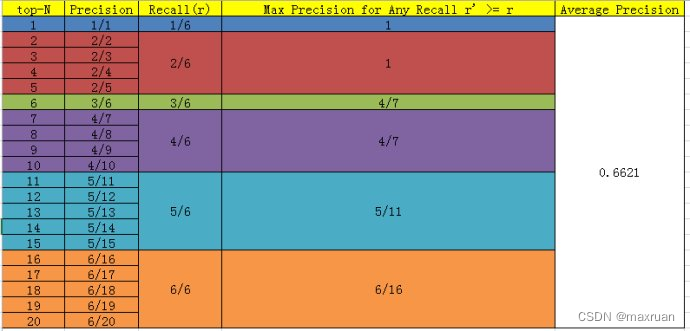

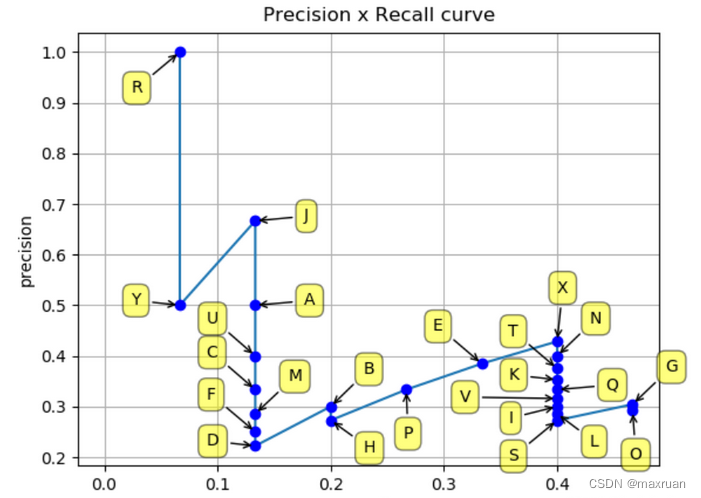 2、所有点插值法(interpolation performed in all points)
2、所有点插值法(interpolation performed in all points)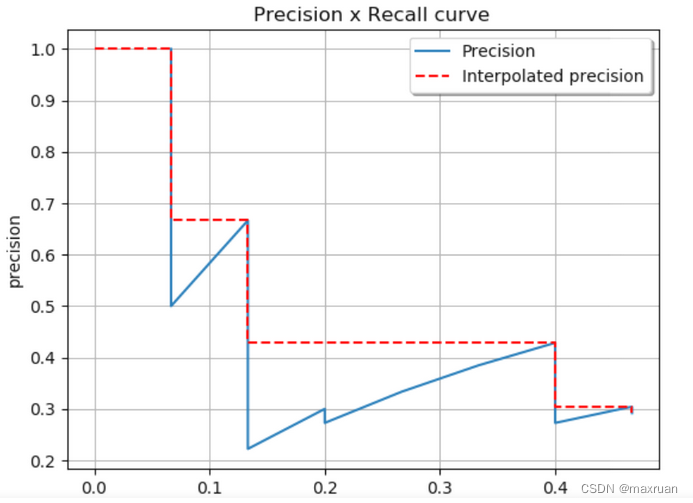 经过插值后,M 个矩形面积即为AP值。
经过插值后,M 个矩形面积即为AP值。 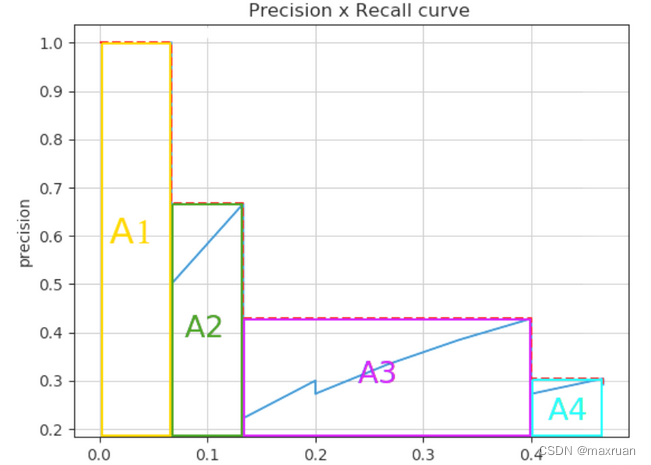 原始AP定义为:
原始AP定义为: 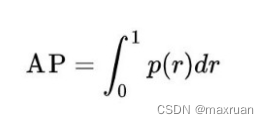 实际上我们都是用矩形插值方式进行近似计算。
实际上我们都是用矩形插值方式进行近似计算。